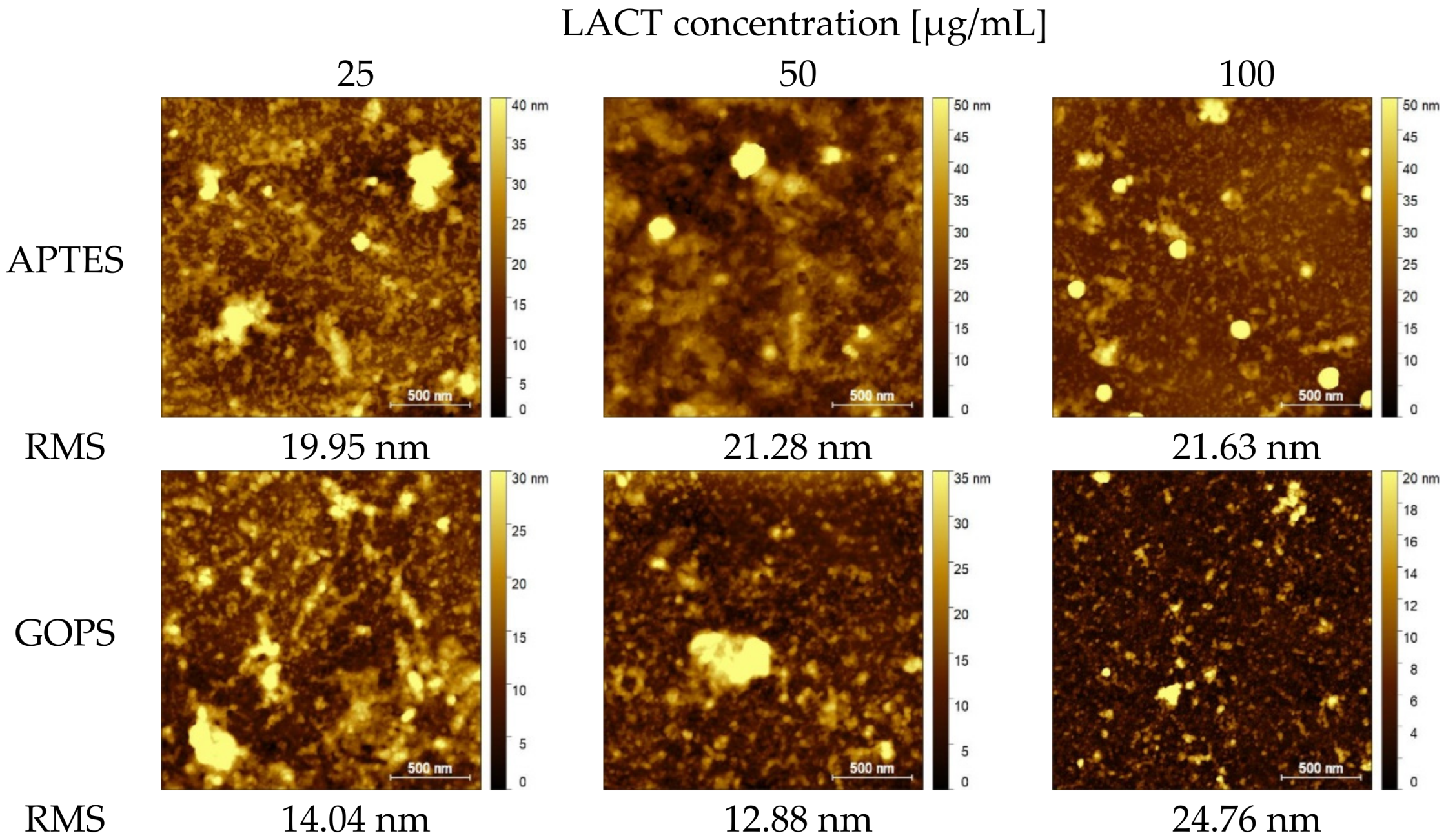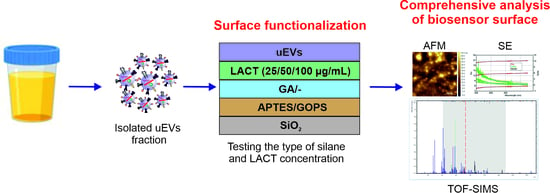Design and Optimization of a Biosensor Surface Functionalization to Effectively Capture Urinary Extracellular Vesicles
Abstract
:1. Introduction
2. Results and Discussion
2.1. Characterization of the Size Distribution and Morphology of uEVs
2.2. Surface Characterization
2.2.1. Estimating the Thickness of the Biomolecular Layer Based on Ellipsometry Measurements
2.2.2. AFM Imaging
2.2.3. ToF-SIMS Analysis
3. Materials and Methods
3.1. Materials and Chemicals
3.2. Isolation of uEVs
3.3. Surface Preparation
3.3.1. Modification of Silicon Substrates
3.3.2. Immobilization of Biomolecules
3.4. UEVs Characterization
3.4.1. UEVs Visualization by TEM
3.4.2. Characterization of uEV Size Distribution by Tunable Resistive Pulse Sensing
3.5. Surface Characterization
3.5.1. Spectroscopic Ellipsometry
3.5.2. Atomic Force Microscopy
3.5.3. Time-of-Flight Secondary Ion Mass Spectrometry
4. Conclusions
Author Contributions
Funding
Institutional Review Board Statement
Informed Consent Statement
Data Availability Statement
Acknowledgments
Conflicts of Interest
References
- Wouters, O.J.; O’Donoghue, D.J.; Ritchie, J.; Kanavos, A.P.G.; Narva, A.S. Early chronic kidney disease: Diagnosis, management and models of care. Nat. Rev. Nephrol. 2015, 11, 491–502. [Google Scholar] [CrossRef] [PubMed] [Green Version]
- Bower, A.; Imbard, A.; Benoist, J.F.; Pichard, S.; Rigal, O.; Baud, O.; Schiff, M. Diagnostic contribution of metabolic workup for neonatal inherited metabolic disorders in the absence of expanded newborn screening. Sci. Rep. 2019, 9, 14098. [Google Scholar] [CrossRef] [PubMed]
- Yoon, J.; Shin, M.; Lee, T.; Choi, J.W. Highly sensitive biosensors based on biomolecules and functional nanomaterials depending on the types of nanomaterials: A perspective review. Materials 2020, 13, 299. [Google Scholar] [CrossRef] [Green Version]
- Bhalla, N.; Jolly, P.; Formisano, N.; Estrela, P. Introduction to biosensors. Essays Biochem. 2016, 60, 1–8. [Google Scholar] [CrossRef] [PubMed] [Green Version]
- Henríquez, L.C.; Acuña, M.B.; Rojas, A.C.; Salmerón, R.C.; Correa, M.L.; Baudrit, J.R.V. Biosensors for the detection of bacterial and viral clinical pathogens. Sensors 2020, 20, 6926. [Google Scholar] [CrossRef]
- Nguyen, H.H.; Lee, S.H.; Lee, U.J.; Fermin, C.D.; Kim, M. Immobilized enzymes in biosensor applications. Materials 2019, 12, 121. [Google Scholar] [CrossRef] [Green Version]
- Nicosia, C.; Huskens, J. Reactive self-assembled monolayers: From surface functionalization to gradient formation. Mater. Horiz. 2014, 1, 32–45. [Google Scholar] [CrossRef] [Green Version]
- Rocchitta, G.; Spanu, A.; Babudieri, S.; Latte, G.; Madeddu, G.; Galleri, G.; Nuvoli, S.; Bagella, P.; Demartis, M.I.; Fiore, V.; et al. Enzyme biosensors for biomedical applications: Strategies for safeguarding analytical performances in biological fluids. Sensors 2016, 16, 780. [Google Scholar] [CrossRef] [Green Version]
- Psarouli, A.; Bourkoula, A.; Petrou, P.; Misiakos, K.; Chaniotakis, N.; Kakabakos, S. Covalent binding vs. adsorption of biomolecules on silicon nitride planar waveguides. Procedia Eng. 2011, 25, 350–353. [Google Scholar] [CrossRef] [Green Version]
- Gajos, K.; Szafraniec, K.; Petrou, P.; Budkowski, A. Surface density dependent orientation and immunological recognition of antibody on silicon: TOF-SIMS and surface analysis of two covalent immobilization methods. Appl. Surf. Sci. 2020, 518, 146269. [Google Scholar] [CrossRef]
- Damborska, D.; Bertok, T.; Dosekova, E.; Holazova, A.; Lorencova, L.; Kasak, P.; Tkac, J. Nanomaterial-based biosensors for detection of prostate specific antigen. Microchim. Acta 2017, 184, 3049–3067. [Google Scholar] [CrossRef] [PubMed]
- Yoo, E.H.; Lee, S.Y. Glucose biosensors: An overview of use in clinical practice. Sensors 2010, 10, 4558–4576. [Google Scholar] [CrossRef] [PubMed] [Green Version]
- Meldolesi, J. Exosomes and Ectosomes in Intercellular Communication. Curr. Biol. 2018, 28, 435–444. [Google Scholar] [CrossRef] [Green Version]
- Doyle, L.; Wang, M. Overview of Extracellular Vesicles, Their Origin, Composition, Purpose, and Methods for Exosome Isolation and Analysis. Cells 2019, 8, 727. [Google Scholar] [CrossRef] [PubMed] [Green Version]
- Rikkert, L.G.; De Rond, L.; Van Dam, A.; Van Leeuwen, T.G.; Coumans, F.A.W.; De Reijke, T.M.; Terstappen, L.W.M.M.; Nieuwland, R. Detection of extracellular vesicles in plasma and urine of prostate cancer patients by flow cytometry and surface plasmon resonance imaging. PLoS ONE 2020, 15, e0233443. [Google Scholar] [CrossRef] [PubMed]
- Chiriacò, M.S.; Bianco, M.; Nigro, A.; Primiceri, E.; Ferrara, F.; Romano, A.; Quattrini, A.; Furlan, R.; Arima, V.; Maruccio, G. Lab-on-chip for exosomes and microvesicles detection and characterization. Sensors 2018, 18, 3175. [Google Scholar] [CrossRef] [Green Version]
- Lu, J.; Pang, J.; Chen, Y.; Dong, Q.; Sheng, J.; Luo, Y.; Lu, Y.; Lin, B.; Liu, T. Application of microfluidic chips in separation and analysis of extracellular vesicles in liquid biopsy for cancer. Micromachines 2019, 10, 390. [Google Scholar] [CrossRef] [Green Version]
- Davies, R.T.; Kim, J.; Jang, S.C.; Choi, E.-J.; Gho, Y.S.; Park, J. Microfluidic filtration system to isolate extracellular vesicles from blood. Lab. Chip 2012, 12, 5202–5210. [Google Scholar] [CrossRef] [Green Version]
- Bahrini, I.; Hanayama, R. Development of a method that delivers drugs to enveloped viruses. Biol. Pharm. Bull. 2019, 42, 977–981. [Google Scholar] [CrossRef]
- Gajos, K.; Kamińska, A.; Awsiuk, K.; Bajor, A.; Gruszczyński, K.; Pawlak, A.; Żądło, A.; Kowalik, A.; Budkowski, A.; Stępień, E. Immobilization and detection of platelet-derived extracellular vesicles on functionalized silicon substrate: Cytometric and spectrometric approach. Anal. Bioanal. Chem. 2017, 409, 1109–1119. [Google Scholar] [CrossRef] [Green Version]
- Shao, C.; Novakovic, V.A.; Head, J.F.; Seaton, B.A.; Gilbert, G.E. Crystal structure of lactadherin C2 domain at 1.7 A° resolution with mutational and computational analyses of its membrane-binding motif. J. Biol. Chem. 2008, 283, 7230–7241. [Google Scholar] [CrossRef] [Green Version]
- Kamińska, A.; Enguita, F.J.; Stępień, E.Ł. Lactadherin: An unappreciated haemostasis regulator and potential therapeutic agent. Vascul. Pharmacol. 2018, 101, 21–28. [Google Scholar] [CrossRef] [PubMed]
- Otzen, D.E.; Blans, K.; Wang, H.; Gilbert, G.E.; Rasmussen, J.T. Lactadherin binds to phosphatidylserine-containing vesicles in a two-step mechanism sensitive to vesicle size and composition. Biochim. Biophys. Acta-Biomembr. 2012, 1818, 1019–1027. [Google Scholar] [CrossRef] [PubMed] [Green Version]
- Neutzner, M.; Lopez, T.; Feng, X.; Bergmann-Leitner, E.S.; Leitner, W.W.; Udey, M.C. MFG-E8/Lactadherin Promotes Tumor Growth in an Angiogenesis-Dependent Transgenic Mouse Model of Multistage Carcinogenesis. Cancer Res. 2007, 67, 6777–6785. [Google Scholar] [CrossRef] [PubMed] [Green Version]
- Ngo, D.; Liu, H.; Sheth, N.; Hallman, R.L.; Podraza, N.J.; Collin, M.; Gin, S.; Kim, S.H. Spectroscopic ellipsometry study of thickness and porosity of the alteration layer formed on international simple glass surface in aqueous corrosion conditions. npj Mater. Degrad. 2018, 2, 20. [Google Scholar] [CrossRef] [Green Version]
- Gunda, N.S.K.; Singh, M.; Norman, L.; Kaur, K.; Mitra, S.K. Optimization and characterization of biomolecule immobilization on silicon substrates using (3-aminopropyl)triethoxysilane (APTES) and glutaraldehyde linker. Appl. Surf. Sci. 2014, 305, 522–530. [Google Scholar] [CrossRef]
- Théry, C.; Witwer, K.W.; Aikawa, E.; Alcaraz, M.J.; Anderson, J.D.; Andriantsitohaina, R.; Antoniou, A.; Arab, T.; Archer, F.; Atkin-Smith, G.K.; et al. Minimal information for studies of extracellular vesicles 2018 (MISEV2018): A position statement of the International Society for Extracellular Vesicles and update of the MISEV2014 guidelines. J. Extracell. Vesicles 2018, 7, 1535750. [Google Scholar] [CrossRef] [Green Version]
- Arwin, H. Ellipsometry on thin organic layers of biological interest: Characterization and applications. Thin Solid Film. 2000, 377, 48–56. [Google Scholar] [CrossRef]
- Bernsmann, F.; Lawrence, N.; Hannig, M.; Ziegler, C.; Gnaser, H. Protein films adsorbed on experimental dental materials: ToF-SIMS with multivariate data analysis. Anal. Bioanal. Chem. 2008, 391, 545–554. [Google Scholar] [CrossRef]
- Kawecki, M.; Bernard, L. Database of proteinogenic amino acid reference spectra for Bismuth-cluster ToF-SIMS. I. Negative polarity. Surf. Sci. Spectra 2018, 25, 15001. [Google Scholar] [CrossRef] [Green Version]
- Kamińska, A.; Gajos, K.; Woźnicka, O.; Dłubacz, A.; Marzec, M.E.; Budkowski, A.; Stępień, E. Using a lactadherin-immobilized silicon surface for capturing and monitoring plasma microvesicles as a foundation for diagnostic device development. Anal. Bioanal. Chem. 2020, 412, 8093–8106. [Google Scholar] [CrossRef]
- Antonucci, J.M.; Dickens, S.H.; Fowler, B.O.; Xu, H.H.K.; McDonough, W.G. Chemistry of Silanes: Interfaces in Dental Polymers and Composites. J. Res. Natl. Inst. Stand. Technol. 2005, 110, 541–558. [Google Scholar] [CrossRef] [PubMed]
- Tang, H.; Zhang, W.; Geng, P.; Wang, Q.; Jin, L.; Wu, Z.; Lou, M. A new amperometric method for rapid detection of Escherichia coli density using a self-assembled monolayer-based bienzyme biosensor. Anal. Chim. Acta 2006, 562, 190–196. [Google Scholar] [CrossRef]
- Hayichelaeh, C.; Reuvekamp, L.A.E.M.; Dierkes, W.K.; Blume, A.; Noordermeer, J.W.M.; Sahakaro, K. Enhancing the silanization reaction of the silica-silane system by different amines in model and practical silica-filled natural rubber compounds. Polymers 2018, 10, 584. [Google Scholar] [CrossRef] [Green Version]
- Barreiro, K.; Huber, T.B.; Holthofer, H. Isolating Urinary Extracellular Vesicles as Biomarkers for Diabetic Disease BT-Diabetic Nephropathy: Methods and Protocols; Gnudi, L., Long, D.A., Eds.; Springer: New York, NY, USA, 2020; pp. 175–188. ISBN 978-1-4939-9841-8. [Google Scholar]
- Drożdż, A.; Kamińska, A.; Surman, M.; Gonet-Surówka, A.; Jach, R.; Huras, H.; Przybyło, M.; Stępień, E.Ł. Low-vacuum filtration as an alternative extracellular vesicle concentration method: A comparison with ultracentrifugation and differential centrifugation. Pharmaceutics 2020, 12, 872. [Google Scholar] [CrossRef] [PubMed]
- Awsiuk, K.; Budkowski, A.; Psarouli, A.; Petrou, P.; Bernasik, A.; Kakabakos, S.; Rysz, J.; Raptis, I. Protein adsorption and covalent bonding to silicon nitride surfaces modified with organo-silanes: Comparison using AFM, angle-resolved XPS and multivariate ToF-SIMS analysis. Coll. Surf. B Biointerfaces 2013, 110, 217–224. [Google Scholar] [CrossRef]
- Kelley, L.A.; Mezulis, S.; Yates, C.M.; Wass, M.N.; Sternberg, M.J. Trabajo práctico N° 13. Varianzas en función de variable independiente categórica. Nat. Protoc. 2016, 10, 845–858. [Google Scholar] [CrossRef] [Green Version]
- Wang, Z.H.; Jin, G. Covalent immobilization of proteins for the biosensor based on imaging ellipsometry. J. Immunol. Methods 2004, 285, 237–243. [Google Scholar] [CrossRef]











Publisher’s Note: MDPI stays neutral with regard to jurisdictional claims in published maps and institutional affiliations. |
© 2021 by the authors. Licensee MDPI, Basel, Switzerland. This article is an open access article distributed under the terms and conditions of the Creative Commons Attribution (CC BY) license (https://creativecommons.org/licenses/by/4.0/).
Share and Cite
Kamińska, A.; Marzec, M.E.; Stępień, E.Ł. Design and Optimization of a Biosensor Surface Functionalization to Effectively Capture Urinary Extracellular Vesicles. Molecules 2021, 26, 4764. https://doi.org/10.3390/molecules26164764
Kamińska A, Marzec ME, Stępień EŁ. Design and Optimization of a Biosensor Surface Functionalization to Effectively Capture Urinary Extracellular Vesicles. Molecules. 2021; 26(16):4764. https://doi.org/10.3390/molecules26164764
Chicago/Turabian StyleKamińska, Agnieszka, Magdalena E. Marzec, and Ewa Ł. Stępień. 2021. "Design and Optimization of a Biosensor Surface Functionalization to Effectively Capture Urinary Extracellular Vesicles" Molecules 26, no. 16: 4764. https://doi.org/10.3390/molecules26164764
APA StyleKamińska, A., Marzec, M. E., & Stępień, E. Ł. (2021). Design and Optimization of a Biosensor Surface Functionalization to Effectively Capture Urinary Extracellular Vesicles. Molecules, 26(16), 4764. https://doi.org/10.3390/molecules26164764







